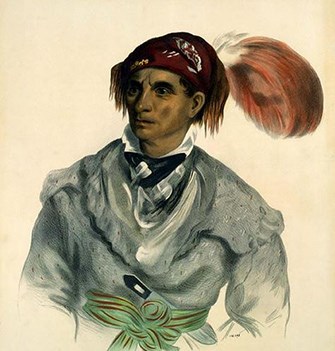Last updated: September 30, 2022
Article
Cherokee of the Creek War (1813 - 1814)
Owing to their disparate backgrounds and, largely volunteer status, Cherokee participants in the Creek War (1813-184) were incredibly varied in terms of clothing worn and armaments employed.
Native communities incorporated some American and European ideas about property and land ownership, farming and animal husbandry, and regimented gender roles. The material culture of the Cherokee was transformed as well.

Smithsonian American Art Museum
The Cherokee of the early 19th century were in a state of transition. Traditional ways were slowly evolving to incorporate American and European ideas about property and land ownership, farming and animal husbandry, and regimented gender roles. It comes as no surprise, therefore, that the material culture of the Cherokee also transformed.
One common request that General Andrew Jackson made of the Cherokee during the Creek War was for warriors to wear either white plumes or deer tails in their hair. Theoretically, these embellishments would aid the United States’ troops in differentiating friend from foe.
As they were not distributed either weaponry or standardized dress, Cherokee participants in the conflict brought their own clothing, provisions, and arms. In terms of clothing, many Cherokee wore a mixture of traditional and American attire such as linen shirts, deerskin moccasins, and leggings. It was not uncommon for warriors to wear beaded or decorative sashes, scarves, belts, and garters. Other ornamentation included silver gorgets, armbands, and earrings. Some Cherokee men continued to shave their heads and sported facial/body tattoos or paint while others wore colorful turbans adorned with feathers or other ornamentation.
The Cherokee also brought with them a diverse array of weaponry. If they came with firearms, examples would have included flintlock pistols, muskets, or rifles. However, many of the Cherokee warriors did not have guns. It was not uncommon for them to employ the bow (traditionally made of Black Locust) and arrow (fletched with turkey feathers) in distance fighting.
Numerous reports of fighting during the Creek War indicate that there was a great degree of ferocious hand-to-hand combat. In such situations, the Cherokee would have used the long knife (later popularized as the “Bowie Knife” after some alterations made to it by Jim Bowie), the war club, and the tomahawk or hatchet. Long knives, with blades from 7 to 12 inches, had a straight back and were often sharpened on a single side. The handles frequently were decorated or carved. War clubs were elaborately carved from single pieces of wood whose length varied from user to user but often were somewhere close to 24 inches in length. Like many other tribes from the Southeast, the Cherokee’s war club featured a heavy balled head that was occasionally fitted with a spike of bone, stone, or metal. The tomahawk was a type of hand axe with a straight shaft and single, usually triangular, axe head. Occasionally, opposite the head was a spike or hammer poll. Tomahawks were extremely popular because, in addition to being invaluable tools, they were very versatile weapons: being thrown accurately with ease or wielded without difficulty in close combat.
